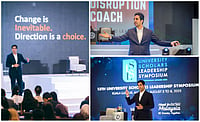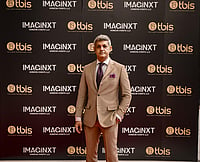In the fast-moving digital economy, Blockchain and Web3 create two major shifts in how people interact over the internet. Both innovations redefine the notion of trust, ownership, and value flow on the internet. While Blockchain itself lays a safe, transparent foundation for recording data and transactions, Web3 builds on this foundation in the form of a decentralized version of the internet, where users really own their data and digital identities.
The early internet, Web1, was all about reading information. Then came Web2, where everyone got to be a creator and share via social media and apps. Now, Web3 means an Internet powered by blockchain technology, cryptocurrency, and smart contracts that bring more transparency, autonomy, and equity to users.
Let's understand this transformation step by step — in simple terms.
Key Highlights
Web3 uses the blockchain to securely record information through a distributed digital ledger.
Web3 is the next evolution of the internet, defined by decentralization, ownership, and peer-to-peer interaction.
Unlike Web2, in Web3 there is no intermediary; in particular, users are in control of data and digital assets.
Smart contracts are automating agreements without the need for banks or middlemen.
Key applications based on Blockchain and Web3 are cryptocurrencies and NFTs.
Put them all together, and they offer opportunities in finance, gaming, real estate, education, healthcare, and lots more.
Understanding Blockchain: The Foundation of Web3
At the most basic level, Blockchain is a specific type of database-a digital ledger that records transactions in a secure, transparent, and tamper-proof manner.
Every transaction is assembled into a block, and each block is connected with the one before it — creating a chain. Hence, the name “blockchain.”
Key Features of Blockchain:
It is decentralized - no company or person owns the system.
Transparency: All the transactions are visible to everyone on the network.
Security - The data is cryptographically encrypted.
Immutability: Data, once entered, is never to be modified.
Trustless system: Users have the potential to transact without a trusted intermediary.
Blockchain technology ensures that every record is verified by multiple computers, called nodes, across the world. This makes hacking or manipulation nearly impossible.
What is Web3?
Web3, better known as Web 3.0, would be the next generation of the internet, which runs on blockchain networks instead of centralized servers. It will grant users control, privacy, and ownership of their online data and activities.
That is,
Web1 = Read
Web2 = Read + Write
Web3 = Read + Write + Own
In Web3, you don't just use applications-you own a piece of them. You can earn tokens for participating, vote for changes in decentralized communities, and keep your data private using blockchain-based identities.
Core Principles of Web3
Decentralized: It is owned by no central authority, neither Google nor Meta.
Ownership: Data, assets, and identity remain owned by the users.
Incentivization: Participation is incentivized using cryptocurrencies or tokens.
Interoperability: The applications are able to share information among themselves.
Transparency: All transactions are recorded on a public ledger.
How Blockchain Powers Web3
Without blockchain, there would be no Web3. In simple terms, blockchain supplies the decentralized internet with its 'engine.' It confirms that transactions are transparent and secure with no intermediaries.
1. Smart Contracts
These are the self-executing agreements in code: two parties agree to exchange tokens, for example, and the smart contract automatically completes the transaction when conditions are met — all without lawyers or banks.
2. Decentralized Applications (dApps)
Web3 applications are called dApps, short for decentralized applications. They run on blockchain networks, not on centralized servers. Examples include:
Uniswap is a decentralized exchange.
OpenSea is a marketplace for NFTs.
Decentraland is a virtual world where users purchase and sell land as NFTs.
3. Cryptocurrencies
The medium of exchange in Web3 involves cryptocurrencies such as Bitcoin, Ethereum, and Solana. With it, people can send money all around the world in seconds, without banks.
NFTs are digital assets that represent ownership of unique items, including art, music, or virtual real estate; they manifest a way in which blockchain enables true digital ownership.
The Development of the Internet
Let's start with a brief overview of how the Internet has become Web3:
Web1 (1990s – early 2000s)
Static web pages.
Read-only experience.
Minimal user interaction.
Web2 (2004 – present)
Social media, e-commerce, and user-generated content.
Centralized platforms include Facebook, Google, and YouTube.
Data collected and monetized by corporations.
Web3: Emerging now
Decentralized and user-owned.
Built on blockchain and token economy.
Focused on privacy, ownership, and transparency.
Why Web3 Matters
For a long time, the internet was controlled by a few tech giants. Web3 works by distributing power across users.
Benefits of Web3:
User empowerment: You own your content and data.
Fair Rewards: You get paid right away for your contributions.
Privacy: No central body is collecting or selling your personal data.
Global access: Since it's online, anyone who has access to the internet can join in.
Transparency: All transactions are transparent and traceable.
Web3 creates an ecosystem of trustlessness where transparency comes in place of reliance on a centralized authority.
Real-World Use Cases of Blockchain and Web3
1. Finance (DeFi)
DeFi decentralized finance replaces banks with blockchain-based systems. One can lend, borrow, and even trade cryptocurrencies without intermediaries.
2. Play-to-earn gaming
Games like Axie Infinity and The Sandbox reward their players with tokens and non-fungible tokens, hence allowing them to make real-life revenues.
3. Supply Chain Management
Blockchain offers source-to-sale product tracking, therefore less fraud and greater authenticity.
4. Healthcare
It helps in maintaining patient records on blockchain with secure access to only authorized users.
5. Education
Blockchain verifies academic records and certificates to avoid forgery.
6. Digital Identity
Web3 lets users manage their digital identity independently, without necessarily having to rely on social media logins.
Limitations and Challenges
Of course, there are many challenges facing Blockchain and Web3, even with their bright future:
Scalability: Thousands of transactions per second are tough to compute.
Energy Consumption: Most blockchains, especially Bitcoin, are generally very power-consuming.
Regulation: Most governments are still grappling with how to handle regulation in the case of distributed systems
User Experience: To the average person, Web3 is daunting.
Security Risks: Major threats include scams, phishing, and wallet hacks.
Overcoming these challenges will hold the key to mainstream adoption.
The Power of Community in Web3
A strong feature of Web3 is community ownership. While old organizations do have top-down hierarchies, in the case of Web3 projects they most often grow through Decentralized Autonomous Organizations. Online communities decide the next course of action by actively collaborating with token holders.
In the DAO, every member has the right to vote for proposed ideas, raise their own, or influence in which direction the development of a particular project may go. This approach eliminates all kinds of centralized control, and different stakeholders take part in the process of development.
A music DAO, for example, would vote on the distribution of profit among members, whereby both artists and fans have a say. A gaming DAO may allow players to vote on new game features. By creating a democratic and transparent structure, it strengthens and activates the community, giving people a sense of ownership in the platforms they help shape-not just financial, but even emotional.
The Token Economy: Re-imagining Value on the Internet
Another main concept of Web3 is the token economy. Basically, value in traditional systems is shown through money, while in Web3, this value, reputation, and ownership are manifested through tokens that digitally exist on a blockchain.
Types of Tokens:
Utility Tokens: These are designed to provide access to services (e.g., paying fees or gaining access to an app).
Governance Tokens: Provide voting power in DAOs and decentralized projects.
Security Tokens: These are representative investment assets or shares in a company.
NFTs represent unique items, usually art, property, or collectibles.
Why Tokens Matter
Tokens create a shared economy in which participants are incentivized, not just the owners of the platform. For example:
Users can earn tokens for sharing content.
Developers can be paid directly for building applications.
Artists can sell their digital creations without intermediaries. The system encourages fairness and cooperation, sparking creativity and innovation, as well as user loyalty.
Web3 and the Metaverse: The Next Frontier
The metaverse and Web3 are inextricably linked. In particular, whereas the metaverse is all kinds of fully immersive virtual worlds where people can interact with each other, work, or play, using digital avatars, Web3 provides the infrastructure that can make the metaverse functional and fair.
Think about it: strolling in the digital city of the metaverse, the buildings you see are owned by other users as NFTs; buying clothes for your avatar with cryptocurrency, or attending a concert by an artist from any part of the world-all on blockchain technology.
Basically,
Web3 enables ownership.
Blockchain ensures transparency.
The metaverse delivers the experience.
This would create an open, user-driven virtual economy both reflective and sometimes improving on reality.
Sustainability and Green Blockchain
One of the greatest criticisms leveled against blockchain has been its energy consumption, especially by those chains utilizing the Proof of Work system. Examples include Bitcoin. Newer blockchains have been addressing this through their development and the adoption of greener alternatives using the Proof of Stake and Proof of Authority consensus algorithms.
Examples: Ethereum 2.0 moved to PoS from PoW and, in so doing, reduced energy consumption by more than 99%. Similarly, Solana and Polygon operate on green consensus mechanisms.
These changes help make blockchain more sustainable, meaning the world can adopt it at scale without harm to the planet. Most new Web3 projects in the future will run on green and energy-efficient systems that fit within worldwide goals for sustainability and responsible innovation.
Bridging the Gap: Web2 to Web3 Transition
The transition from Web2 to Web3 isn't happening overnight. It's actually a gradual one whereby many companies are incorporating Web3 elements into traditional Web2 platforms. For instance:
Social media applications are considering the use of NFT profile pictures.
E-commerce stores that accept cryptocurrency as a form of payment.
Streaming services rewarding users with tokens.
This hybrid approach helps users adapt to new systems while retaining familiar experiences. As the infrastructure of blockchain gets faster and cheaper with time, we will see a smoother and wider adoption of full Web3 ecosystems.
The Future of Blockchain and Web3
In the future, Web3 is likely to merge with other emerging technologies like AI, AR/VR, and IoT. Imagine a virtual world where:
You shop using crypto wallets.
Attend concerts in metaverse spaces.
And your virtual home ownership is verified by a blockchain NFT.
Expected Trends:
Mass Adoption of Digital Wallets
More users will be paying with and verifying their identities using wallets like MetaMask.
Interoperability Between Chains
Different chains will work together, increasing efficiency.
Green Blockchain Solutions
Energy-heavy mining will be replaced by eco-friendly systems like Proof of Stake.
Web3 in Governments and Education
Decentralized voting, transparent record systems, and blockchain credentials will become common.
Common Misconceptions About Blockchain and Web3
"Blockchain is only for cryptocurrency."
False - it is used in healthcare, logistics, identity, and voting.
“Web3 is unsafe.”
In fact, Web3 is more secure because of encryption and decentralization.
“It’s just a fad.”
Web3 is still developing, much as the early internet was, but its base is strong.
FAQs: Blockchain and Web3
Q1. What is the main difference between Blockchain and Web3?
Blockchain is the technology-essentially, the foundation-whereas Web3 is the ecosystem built on top that enables decentralized internet experiences.
Q2. Is Web3 the same as cryptocurrency?
No, cryptocurrencies represent a part of Web3, but Web3 incorporates more: decentralized apps, NFTs, and digital identities.
Q3. Can anyone use Web3?
Yes. Each owner of an internet connection and a crypto wallet can interact with Web3 websites.
Q4: Is Web3 secure?
Generally, yes, but one should be very careful about scams, fake projects, and phishing links.
Q5. How does Web3 change Social Media?
Web3 social media platforms let users possess the ownership of their content and earn tokens for engagement rather than letting companies profit off user data in the case of Web2.
Q6. Will Web3 replace the current internet? It may not replace Web2 entirely, but it will run alongside and improve privacy, transparency, and ownership.
Conclusion
The Road Ahead But blockchain and Web3 are about more than technology shifts; it's about reshaping digital trust and ownership. A decentralized world will mean users can own and decide how they connect, share, and transact on the internet. The transition won't happen overnight, but one thing is for sure: The future of the internet is open, decentralized, and user-owned. Blockchain and Web3 are building the next digital revolution, from finance to art, education, and governance-one block at a time.





















